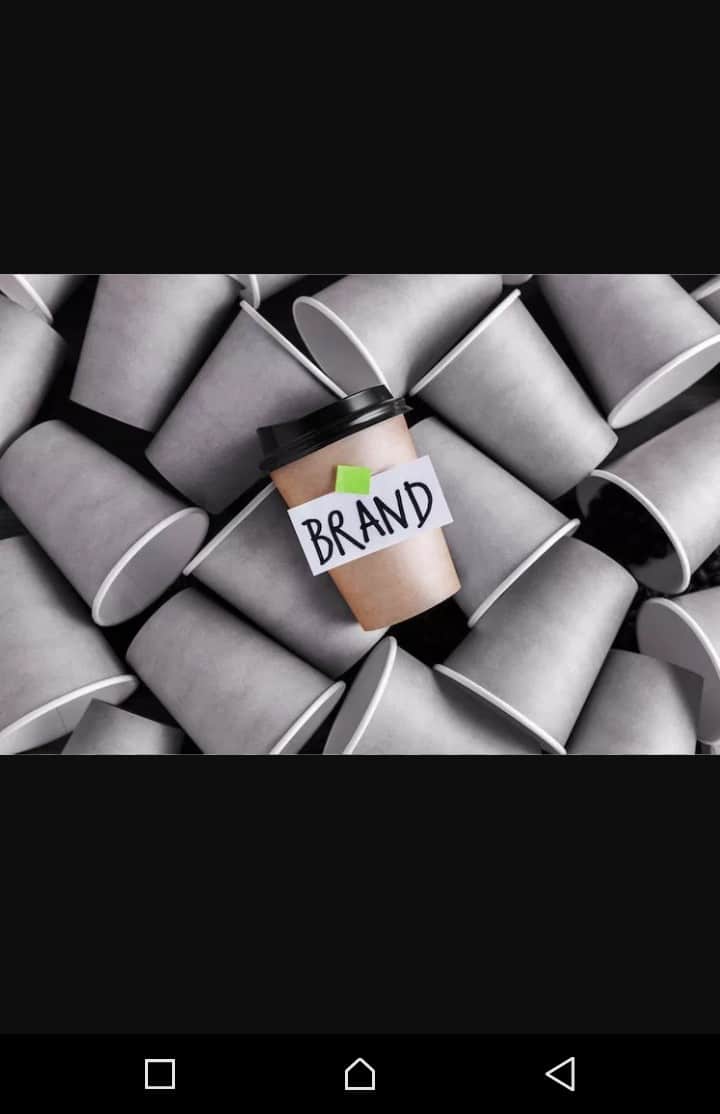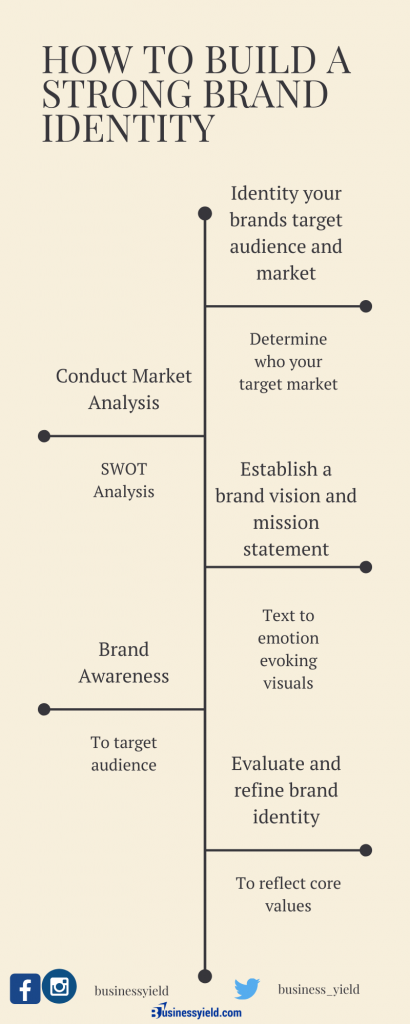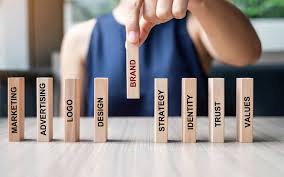A brand identity is more than just a colourful logo or style guide. It should represent brand reputation, connection, emotion, and style. Here are the tips to build a strong brand identity for your business whether a startup or an already existing one. Also you’ll see the usefulness of brand identity designers in creating a unique design strategy for your business.
What Is a Brand Identity?
Brand identity influences customers to experience relevance, reputation, and credibility.
Brand identity is a sum total of how your brand looks, feels, sounds and is perceived – the element that enhances engagement.
It is visual and emotional and communicates credibility and dedication. Some brand identities are tied to practical elements like visuals, design, and packaging.
Keys to a Good Brand Identity
A good brand identity should have the following characteristics:
- Memorable: A brand should have a memorable visual impact. Consider brands like Apple, their logo is very memorable, they use it not their names.
- Flexible: It should be flexible enough to grow with the brand.
- Distinct: It should catch the audience’s attention and be stand out among competitors.
How to Design Your Brand Identity in Easy Steps
There are six steps to designing your brand identity, which will provide you with a set of resources that will bring clarity and distinctiveness to your brand. These processes include defining your target audience, clarifying your product, picking colors, developing your logo, selecting fonts, and putting it all together in a brand style guide.
You can complete all of these processes on your own, but you may want to consider partnering with a brand identity design agency like DesignBro to assist you. Many design firms understand the importance of aesthetics and have experience in shaping a brand’s identity. The first three parts of this process take only a few hours, and the next three processes are outsourced to an agency for a few hundred dollars.
Inc.com agrees with these steps written below;
Let’s take a closer look at each of the six steps:
#1. Identify Your Ideal Customer
The building block of every brand is to identify the target audience it will be focusing on.
Before you can do things like choose a logo and design your visuals, you must first define your target customer. This is a crucial first step because it will influence the rest of your decisions throughout the brand design process. The brand colors you choose, the logo you develop, and the overall message you express are all determined by your target customer.
You will first construct a clear image of your target customer, commonly known as an avatar. Understanding your target customer’s demographics and psychographics are the first steps in defining them.
Determine the Demographics of Your Target Market
Demographics are statistical statistics such as age, gender, location, and educational level, which are normally gathered in a census. This is critical information to collect about your target market. The better you understand who they are, the more effectively you will be able to establish a brand identity that connects with them, persuades them, and retains them.
By asking the following questions, you will be able to determine your target market demographics:
- What gender are they?
- What is their age and marital status?
- Where do they call home?
- What is their line of work?
- What is their degree of income?
These are just the beginning. You may also want to identify concerns such as ethnicity, education level, living condition, home, religion, or physical traits, depending on your product or service. If you own a pizza, for example, you may wish to collect demographic information on the variety and prevalence of food allergies in your neighborhood.
Determine the Psychographics of Your Target Market
Psychographics is the classification of people based on their attitudes and aspirations, and it is critical when designing your brand identity. Whereas market demographics offer you with metrical data on your client, market psychographics delve into your target consumer’s thoughts, lifestyle, choices, pain spots, belief systems, and goals.
Here are three good psychographic questions to ask your target market:
- What types of activities do they engage in?
- What are their pain issues in terms of the product or service you’re offering?
- So, what are their values in terms of the product or service you’re offering?
Other psychographic factors to examine include culinary preferences, political beliefs, entertainment interests, and spending patterns. Perhaps you reside in a location where the primary spenders are the spouses of corporate leaders, with fashion products as their primary spending goal. If you want your business to prosper, you must establish a brand identity design that appeals to these consumers.
This step’s end result should be a customer avatar. You should provide your avatar a name and a picture. Download our customer profile template once more to develop this profile of your customer. The template defines the procedure in great detail and provides you with a clear picture of people you’re attempting to reach.
#2. Defining Your Value Proposition
Write down exactly what you’re selling and how it differs from other products or services on the market in this phase. This step, also known as the value proposition, should result in a clear one- or two-sentence statement that defines what your product or service is and why it is important to your ideal consumer.
When defining the worth of what you’re selling, strive to be as specific as possible. Something ambiguous like “ACME Apparel sells T-shirts” is ineffective. Instead, try this: “ACME Apparel sells amusing and eye-catching graphic T-shirts for new fathers who enjoy strength training.” If you have a number of items or services, make a list of them.
It is hard to create a brand identity without first defining your company’s distinctive value. Rolls-Royce, for example, a brand dedicated to luxury and excellent quality, has a logo and mascot that gently communicate these principles. This brand identity differs from that of a more playful corporation, such as Disney World, which has a more casual brand identity.
See Also: Google Brand Strategy: How Google dominates Markets.
#3. Select Your Brand’s Colors
We’ve built the groundwork for the aesthetics in the first two steps. You understand your customer, and you now understand your unique value proposition. Your brand’s graphics will be defined by these tenets. Step three involves selecting three brand colors: the primary brand color, a secondary color, and a neutral foundation color. This process should result in at least three hex codes of your chosen colors that represent your value to your target consumer.
Brand colors serve as the foundation for all of your graphics, most notably your logo. The colors of your brand will appear on everything – business cards, billboards, signage, websites, automobiles, and anyplace else your company has a presence. Your chosen colors are a clear indication to your customers that this is your brand, what it looks like, and what it delivers.
You may properly select the colors for your brand by following the two procedures outlined below:
1. Recognize Color Psychology
Color psychology proposes that different hues may have distinct effects on the brain. Color association differences between cultures can play a role. It’s not an exact science, but there are broad trends to be aware of.
The following are some of the most common emotions or feelings associated with each major color:
- Red represents danger, passion, love, and urgency.
- Yellow represents joy, warmth, and optimism.
- Blue represents peace, trust, and security.
- Orange represents excitement, prudence, and self-assurance.
- Green represents health, nature, and progress.
- Purple represents royalty, beauty, and wisdom.
- Pink symbolizes romance, femininity, and gentleness.
- Black represents luxury, secrecy, and hiding.
- White represents purity, openness, and transparency.
- Identity of a brand
- Creative Explosion
You should be able to discover colors that resonate with your target market based on color psychology and an understanding of your customer. Some aspects of color psychology may seem intuitive. For example, if your CrossFit facility is aimed at blue-collar, 20-something males, you might want to use a hue other than pink as the main color.
2. Select Your Three Colors
First, choose the primary brand color, as this will be a distinctive element of your brand – think Coca-red Cola’s or UPS’s brown. A contrasting color will be used for your secondary brand color. Finally, a neutral color serves as a chromatic backdrop and improves the overall coherence of the design pieces.
Here are the three color options you’ll have:
- Your primary brand color: This is the color that people will associate with your company.
- Your secondary brand color: Many companies utilize multiple colors. Some, such as Google, employ more than three hues. This color should be a contrast to your main color, but it should not clash with it.
- A neutral foundation color: Something like white is the safest bet.
How do you go about picking the perfect color? Easy. Simply search for “color chooser.” In the search engine results page, you should see something similar to this. When you’ve found the perfect color, make a note of the hex code — the six-value set of colors and numbers that describes the color you’ve chosen.
#4. Create a Logo
In this stage, you will build a professionally designed logo that symbolizes your company’s beliefs, targets your target audience, and incorporates the colors you have chosen. The final stage is to design your logo, which is the culmination of the previous three processes. You are crystallizing one of the most memorable and recognized components of your brand identity design through the logo design process.
Because this is such an important phase, I recommend entrusting the logo design process to a design firm that specializes in logo creation, such as DesignBro. Professional logo design can range from a few dollars (fiverr) to a few hundred thousand dollars (Rob Janoff, Apple’s logo designer). You might not be able to afford Janoff’s services, but you should not scrimp on logo design. The heart of your brand identity design is your logo. The quality of your logo reflects the worth of your brand.
How to Select the Best Logo Design Company
When working with a logo design agency, you will usually give them as much information about your company, products, and clients as possible. Once you’ve provided this information, agency designers or individual designers will create logo suggestions for you. Following that, you’ll be able to choose your favourite design, request any necessary changes, and eventually decide on something satisfactory.
When choosing a logo design service, look for the following characteristics:
- Appropriate price (between $300 and $1,000): Low-cost logos are almost never custom-designed logos. You’ll have to pay a professional for the time it takes to grasp your customer, products, and messaging. Typically, this will set you back several hundred dollars.
- Design alternatives: Most logo designers will supply a variety of logos. Seeing the different possibilities aids in defining the visual style you want for your brand.
Keep in mind that brand identity design is more than just a logo. Look for a designer who can also create business cards, letterheads, and other design goods.
- Collaborative: Ideally, you are more knowledgeable about your product and market than the designer. As a result, as part of the logo design process, you should be able to share this information with them. You may even have some design concepts in mind that you’d like them to develop, or examples of logos that you like. Quality designers frequently solicit this feedback as part of the design process.
#5. Choose Your Brand’s Fonts
The goal of choosing fonts for your brand is to create a coherent design for your brand. Although fonts are not as visible as a brand logo or color, they play an important role in how recognized your brand is and the style that you want to portray. As part of this process, you should usually choose up to three fonts.
Choose Three Fonts
- You will select three fonts: one for your logo, one for significant headers, and one for regular website or written material. These three fonts will provide a consistent visual front for all of your written material, whether it’s on a billboard, truck, apron, or anything else. (beyoung.in)
- The font used in your logo: Your logo font is the most significant of your brand’s fonts because it establishes the style for the other fonts. If you’ve finished step four — logo design — you’ve already chosen your logo font.
- Secondary font: Your secondary font will be used as the text on your website’s header, signage, business cards, and letterhead. Select a typeface that is similar to the font used in your logo. For example, if your logo font is sans serif, your secondary font should be sans serif as well.
- Copy font: This font’s aim is to create consistency across your brand – general website copy, menus, memos, letters, PowerPoint presentations, and wherever else. This typeface is the simplest of all – consider Arial or Times New Roman.
If your brand has a website, you’ll want to pick an Internet-safe typeface. This isn’t hard to do. The procedure I’ve detailed below will give you a list of such fonts.
What Fonts Should You Use?
Here are three excellent resources for selecting fonts. Each of the resources listed below includes web-safe fonts, so you can easily utilize them on your website.
- Google Fonts: There are 877 font families in Google’s library. You can narrow down your search by common styles such as serif, sans serif, display, handwritten, and monospace, as well as thickness, slant, and width.
- Adobe Typekit: Adobe has a larger range of fonts than Google, however the majority are not free (average price: $29.99). Although some of the styles are more ideal for logos, its filtering tools allow you to choose exactly what you want to look at.
- Wordmark.it: This tiny application allows you to browse a small number of fonts. There are no filtering options, but it’s a quick method to see what fonts and font styles are available.
#6. Make a Brand Style Guide.
A brand style guide’s purpose is to provide detailed guidelines for each element of your brand’s visual identity. This resource is also known as a brand book, brand identity manual, or brand style guide. It is typically a PDF or webpage that offers instructions for or links to all of the above-mentioned brand identity design information and resources. All of your graphic resources will be kept or linked to in your brand style guide.
Here’s an example of a brand identity design (also known as corporate identity) for FedEx, a brand that will be used as an example further down. However, each brand’s style guide will be unique. A winemaker, for example, should have detailed knowledge regarding label sizing, brand placement and so on. A restaurant owner may have preferences for menu layout, fonts for main courses, fonts for dish descriptions, and so on.
See Also: How Cisco Brand Positioning is Making them Stronger.
Here are some examples of assets to add in your brand style guide:
- Business cards: Business cards are one of the easiest ways to distribute your business identification. Your corporate cards will at the very least include your brand’s colors and emblem.
- Letterhead and envelopes: Standard brand identification design should contain a letterhead that includes your logo and, in many cases, your brand colors.
- Website: One of the major ways that a brand’s identity is displayed is through website colors. When you’re updating your brand identity, your website will probably need a refresh too.
If you sell actual things, you’ll need a way to package them. Whether it’s a coffee bag, cupcake box or napkin, your bespoke packaging should convey your brand’s aesthetic identity.
- Uniforms: What your team members wear can convey the design of your brand’s identity. If you sell clothing as part of your business, the look of that apparel will be determined by your brand identity design.
Every resource your firm uses should be described in this style guide. Think of it as a resource for all things visual. You will add to the style guide when you add new designs, such as a new shopping bag design. The style guide houses all of the design details, allowing you to maintain the cohesiveness that is essential for brand identity creation.
What Do Brand Identity Designers Do?
Brand identity designers employ strategy to build your brand’s visual aspects. Your logo, color palette, typography, picture style, and overall look and feel are examples of these elements. These should be specific to your business. They should aid in the representation of your brand. Brand identity designers are not going to make your plant’s conveyor belt run faster or advise you which staff to hire. However, by developing an acceptable, consistent appearance and feel, they can affect the public’s image of you.
Benefits of Hiring Brand Identity Designers for Your Company
Perhaps you are a tiny business starting from scratch. Perhaps you’ve been in business for a while and are thinking if it’s time to refresh your brand identity. After all, you’ve come this far! Is it worthwhile to invest in better design?
It’s probably not worth it for firms who get all of their customers through local referrals and are happy with it. Consider plumbers, mechanics, and dentists. Nobody cares if their looks are mediocre as long as their service is excellent.
However, if you’re in a competitive market or an area where aesthetics can improve income (think food and beverage, hospitality, fashion, financial services, health and wellness, and so on), an identity designer can help. If your objective has changed, your audience has changed, or you have new competition, you may need to renew your brand. Perhaps you have a nagging feeling that your current identity design is out of date.
Do you have any questions? Leave it in the comment box. We will love your feedback.
Brand Identity FAQ’s
Why is brand identity important?
Customers are far more likely to remember your company if it has a strong brand identity. A good brand name and logo/image helps to keep your company in the minds of your potential customers. Customers that are pleased with your brand are more inclined to recommend you to others.
What is included in a brand identity?
The brand identity encompasses logos, typography, colors, packaging, and messaging, and its supplements and strengthens a brand’s existing reputation. A brand’s identity draws new customers while also making existing customers feel at ease.
What is brand identity vs branding?
A brand is a relationship between a company and its customers. What we can perceive is brand identity, which is the design of a brand. Branding is the process of increasing awareness and extending loyalty.
What is a brand identity package?
A branding package is a set of digital, printed, or physical resources used to establish a consistent image for a company. It is made up of distinct branded things that have the same style and ideals. There are various common scenarios in which businesses may acquire bulk design services.
How much should I charge for a brand identity?
Brand identity fees can range from $5 to $5,000 or more: Canva allows you to create a logo for free! For as little as $5, you can hire an anonymous designer through a service like Wix.com or Fiverr.com. Graphic designers with little expertise will charge between $250 and $800 per hour.
{
“@context”: “https://schema.org”,
“@type”: “FAQPage”,
“mainEntity”: [
{
“@type”: “Question”,
“name”: “Why is brand identity important?”,
“acceptedAnswer”: {
“@type”: “Answer”,
“text”: “
Customers are far more likely to remember your company if it has a strong brand identity. A good brand name and logo/image helps to keep your company in the minds of your potential customers. Customers that are pleased with your brand are more inclined to recommend you to others.
“
}
}
, {
“@type”: “Question”,
“name”: “What is included in a brand identity?”,
“acceptedAnswer”: {
“@type”: “Answer”,
“text”: “
The brand identity encompasses logos, typography, colors, packaging, and messaging, and its supplements and strengthens a brand’s existing reputation. A brand’s identity draws new customers while also making existing customers feel at ease.
“
}
}
, {
“@type”: “Question”,
“name”: “What is brand identity vs branding?”,
“acceptedAnswer”: {
“@type”: “Answer”,
“text”: “
A brand is a relationship between a company and its customers. What we can perceive is brand identity, which is the design of a brand. Branding is the process of increasing awareness and extending loyalty.
“
}
}
, {
“@type”: “Question”,
“name”: “What is a brand identity package?”,
“acceptedAnswer”: {
“@type”: “Answer”,
“text”: “
A branding package is a set of digital, printed, or physical resources used to establish a consistent image for a company. It is made up of distinct branded things that have the same style and ideals. There are various common scenarios in which businesses may acquire bulk design services.
“
}
}
, {
“@type”: “Question”,
“name”: “How much should I charge for a brand identity?”,
“acceptedAnswer”: {
“@type”: “Answer”,
“text”: “
Brand identity fees can range from $5 to $5,000 or more: Canva allows you to create a logo for free! For as little as $5, you can hire an anonymous designer through a service like Wix.com or Fiverr.com. Graphic designers with little expertise will charge between $250 and $800 per hour.
“
}
}
]
}







